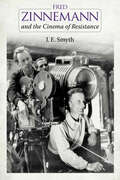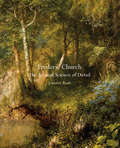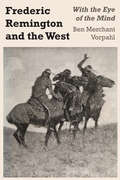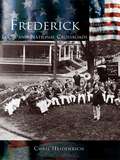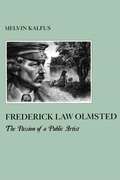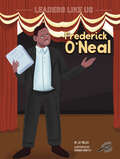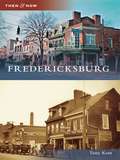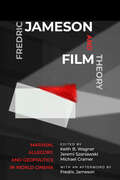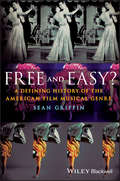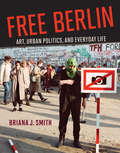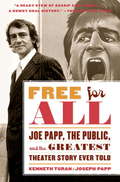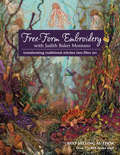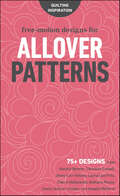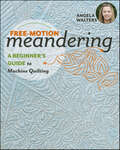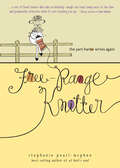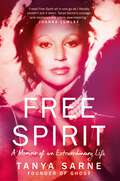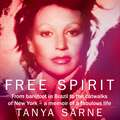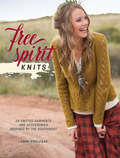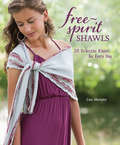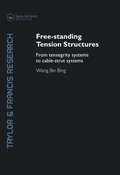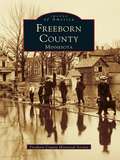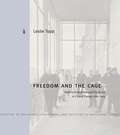- Table View
- List View
Fred Zinnemann and the Cinema of Resistance
by J. E. SmythFred Zinnemann directed some of the most acclaimed and controversial films of the twentieth century, yet he has been a shadowy presence in Hollywood history. In Fred Zinnemann and the Cinema of Resistance, J. E. Smyth reveals the intellectual passion behind some of the most powerful films ever made about the rise and resistance to fascism and the legacy of the Second World War, from The Seventh Cross and The Search to High Noon, From Here to Eternity, and Julia. Smyth's book is the first to draw upon Zinnemann's extensive papers at the Academy of Motion Picture Arts and Sciences and brings Fred Zinnemann's vision, voice, and film practice to life. In his engagement with the defining historical struggles of the twentieth century, Zinnemann fought his own battles with the Hollywood studio system, the critics, and a public bent on forgetting. Zinnemann's films explore the role of women and communists in the antifascist resistance, the West's support of Franco after the Spanish Civil War, and the darker side of America's national heritage. Smyth reconstructs a complex and conflicted portrait of Zinnemann's cinema of resistance, examining his sketches, script annotations, editing and production notes, and personal letters. Illustrated with seventy black-and-white images from Zinnemann's collection, Fred Zinnemann and the Cinema of Resistance discusses the director's professional and personal relationships with Spencer Tracy, Montgomery Clift, Audrey Hepburn, Vanessa Redgrave, and Gary Cooper; the critical reaction to his revisionist Western, High Noon; his battles over the censorship of From Here to Eternity, The Nun's Story, and Behold a Pale Horse; his unrealized history of the Communist Revolution in China, Man's Fate; and the controversial study of political assassination, The Day of the Jackal. In this intense, richly textured narrative, Smyth enters the mind of one of Hollywood's master directors, redefining our knowledge of his artistic vision and practice.
Frederic Church
by Jennifer RaabFrederic Church (1826-1900), the most celebrated painter in the United States during the mid-19th century, created monumental landscapes of North and South America, the Arctic, and the Middle East. These paintings were unsurpassed in their attention to detail, yet the significance of this pictorial approach has remained largely unexplored. In this important reconsideration of Church's works, Jennifer Raab offers the first sustained examination of the aesthetics of detail that fundamentally shaped 19th-century American landscape painting. Moving between historical context and close readings of famous canvases--including Niagara, The Heart of the Andes, and The Icebergs--Raab argues that Church's art challenged an earlier model of painting based on symbolic unity, revealing a representation of nature with surprising connections to scientific discourses of the time. The book traces Church's movement away from working in oil on canvas to shaping the physical landscape of Olana, his self-designed estate on the Hudson River, a move that allowed the artist to rethink scale and process while also engaging with pressing ecological questions. Beautifully illustrated with dramatic spreads and striking details of Church's works, Frederic Church: The Art and Science of Detail offers a profoundly new understanding of this canonical artist.
Frederic Remington and the West: With the Eye of the Mind
by Ben Merchant VorpahlA biography of the artist examining his complex relationship with the American West and how he expressed his imagination.Frederic Remington and the West sheds new light on the remarkably complicated and much misunderstood career of Frederic Remington. This study of the complex relationship between Remington and the American West focuses on the artist&’s imagination and how it expressed itself. Ben Merchant Vorpahl considers all the dimensions of Remington&’s extensive work, from journalism to fiction, sculpture, and painting. He traces the events of Remington&’s life and makes extensive use of literary and art criticism and nineteenth-century American social, cultural, and military history in interpreting his work.Vorpahl reveals Remington as a talented, sensitive, and sometimes neurotic American whose work reflects with peculiar force the excitement and distress of the period between the Civil War and the Spanish-American War. Remington was not a &“western&” artist in the conventional sense; neither was he a historian: he lacked the historian&’s breadth of vision and discipline, expressing himself not through analysis but through synthesis. Vorpahl shows that, even while Remington catered to the sometimes maudlin, sometimes jingoistic tastes of his public and his editors—his resourceful imagination was at work devising a far more demanding and worthwhile design—a composite work, executed in prose, pictures, and bronze. This body of work, as the author demonstrates, demands to be regarded as an interrelated whole. Here guilt, shame, and personal failure are honestly articulated, and death itself is confronted as the artist&’s chief subject. Because Remington was so prolific a painter, sculptor, illustrator, and writer, and because his subjects, techniques, and media were so apparently diverse, the deeper continuity of his work had not previously been recognized. This study is a major contribution to our understanding of an important American artist. In addition, Vorpahl illuminates the interplay between history, artistic consciousness, and the development of America&’s sense of itself during Remington&’s lifetime.
Frederic Remington and the West: With the Eye of the Mind
by Ben Merchant VorpahlA biography of the artist examining his complex relationship with the American West and how he expressed his imagination.Frederic Remington and the West sheds new light on the remarkably complicated and much misunderstood career of Frederic Remington. This study of the complex relationship between Remington and the American West focuses on the artist&’s imagination and how it expressed itself. Ben Merchant Vorpahl considers all the dimensions of Remington&’s extensive work, from journalism to fiction, sculpture, and painting. He traces the events of Remington&’s life and makes extensive use of literary and art criticism and nineteenth-century American social, cultural, and military history in interpreting his work.Vorpahl reveals Remington as a talented, sensitive, and sometimes neurotic American whose work reflects with peculiar force the excitement and distress of the period between the Civil War and the Spanish-American War. Remington was not a &“western&” artist in the conventional sense; neither was he a historian: he lacked the historian&’s breadth of vision and discipline, expressing himself not through analysis but through synthesis. Vorpahl shows that, even while Remington catered to the sometimes maudlin, sometimes jingoistic tastes of his public and his editors—his resourceful imagination was at work devising a far more demanding and worthwhile design—a composite work, executed in prose, pictures, and bronze. This body of work, as the author demonstrates, demands to be regarded as an interrelated whole. Here guilt, shame, and personal failure are honestly articulated, and death itself is confronted as the artist&’s chief subject. Because Remington was so prolific a painter, sculptor, illustrator, and writer, and because his subjects, techniques, and media were so apparently diverse, the deeper continuity of his work had not previously been recognized. This study is a major contribution to our understanding of an important American artist. In addition, Vorpahl illuminates the interplay between history, artistic consciousness, and the development of America&’s sense of itself during Remington&’s lifetime.
Frederick: Local and National Crossroads
by Chris HeidenrichFrederick has stood as the gateway to western Maryland since the 1740s, when German and English settlers moved into the area seeking fertile farmland. Site of the first official rebellious act of the American colonies, early Frederick Town shared the fortunes of the growing nation as proximity to the new capital in Washington and the port of Baltimore fed industry and culture here along the Monocacy River.
Frederick Law Olmstead: The Passion of a Public Artist (The American Social Experience #13)
by Melvin KalfusFrederick Law Olmsted is famous for his urban landscape designs: Central Park in Manhattan, Prospect Park in Brooklyn, and Franklin Park in Boston. Olmsted devoted much of his later life to this work. What was the source of this creative energy and imagination in his fascinating years? Melvin Kalfus is the first author to examine Olmsted's troubled, sometimes tragic childhood and adolescence in a search for the inner sources of his creative imagination. Kalfus argues that Olmsted's distressing early experiences fired his ambition and led him so obsessively to seek the world's esteem through his works. Kalfus also looks at Olmsted's varied early career during which he worked as an apprentice merchant, a seaman, a farmer, a manager of a mining plantation in California, a journalist, and author of three istorically important books on slavery, and as the General Secretary of the Civil War's Sanitary Commission, and enormous project organized to provide medical aid to Union soldiers.
Frederick O'Neal (Leaders Like Us #12)
by J. P. MillerChildren learn about one of the most influential African American leaders in history with the biography of Frederick O’Neal.Not only was Frederick O’Neal a leader and pioneer, but he was also a talented actor and entertainer! Follow along to learn more about Frederick’s life and the contributions he made to the stage.Storybook Features:This children’s book features a glossary with new vocabulary, text-dependent questions, and an extension activity to develop reading comprehension skills.24 pages of vibrant illustrationsLexile 290LAbout RourkeWe proudly publish respectful and relevant non-fiction and fiction titles that represent our diverse readers, and are designed to support reading on a level that has no limits!
Fredericksburg (Then and Now)
by Tony KentFredericksburg, one of America's most historic cities, sits midpoint between the nation's capital and Richmond. Many visitors come to this city to walk in the footsteps of illustrious Americans, admire their homes, view the battlefields nearby, and enjoy true Southern hospitality. Following a broadcasting career in California and New York, author Tony Kent retired to Fredericksburg where he and 12 others founded the Central Rappahannock Heritage Center, a regional archive for the grass roots history of the city and its four neighboring counties. Many never-before-published images in this volume are from the center's collection.
Fredric Jameson and Film Theory: Marxism, Allegory, and Geopolitics in World Cinema
by Dudley Andrew John Mackay Paul Coates Pansy Duncan Naoki Yamamoto Keith B. Wagner Michael Cramer Mercedes Vazquez Alvin K. Wong Dan Hassler-Forest Mike Wayne Jeremi Szaniawski Fredric JamesonFrederic Jameson and Film Theory is the first collection of its kind, it assesses and critically responds to Fredric Jameson’s remarkable contribution to film theory. The essays assembled explore key Jamesonian concepts—such as totality, national allegory, geopolitics, globalization, representation, and pastiche—and his historical schema of realism, modernism, and postmodernism, considering, in both cases, how these can be applied, revised, expanded and challenged within film studies. Featuring essays by leading and emerging voices in the field, the volume probes the contours and complexities of neoliberal capitalism across the globe and explores world cinema's situation within these forces by deploying and adapting Jamesonian concepts, and placing them in dialogue with other theoretical paradigms. The result is an innovative and rigorously analytical effort that offers a range of Marxist-inspired approaches towards cinemas from Asia, Latin America, Europe, and North America in the spirit of Jameson's famous rallying cry: 'always historicize!'.
Free and Easy?: A Defining History of the American Film Musical Genre
by Sean GriffinA History of the American Musical narrates the evolution of the film musical genre, discussing its influences and how it has come to be defined; the first text on this subject for over two decades, it employs the very latest concepts and research. The most up-to-date text on the subject, with uniquely comprehensive coverage and employing the very latest concepts and research Surveys centuries of music history from the music and dance of Native Americans to contemporary music performance in streaming media Examines the different ways the film musical genre has been defined, what gets counted as a musical, why, and who gets to make that decision The text is written in an accessible manner for general cinema and musical theatre buffs, whilst retaining theoretical rigour in research Describes the contributions made to the genre by marginalized or subordinated identity groups who have helped invent and shape the musical
Free Berlin: Art, Urban Politics, and Everyday Life
by Briana J. SmithAn alternative history of art in Berlin, detaching artistic innovation from art world narratives and connecting it instead to collective creativity and social solidarity.In pre- and post-reunification Berlin, socially engaged artists championed collective art making and creativity over individual advancement, transforming urban space and civic life in the process. During the Cold War, the city&’s state of exception invited artists on both sides of the Wall to detour from artistic tradition; post-Wall, art became a tool of resistance against the orthodoxy of economic growth. In Free Berlin, Briana Smith explores the everyday peculiarities, collective joys, and grassroots provocations of experimental artists in late Cold War Berlin and their legacy in today&’s city.These artists worked intentionally outside the art market, believing that art should be everywhere, freed from its confinement in museums and galleries. They used art as a way to imagine new forms of social and creative life. Smith introduces little-known artists including West Berlin feminist collective Black Chocolate, the artist duo paint the town red (p.t.t.r), and the Office for Unusual Events, creators of satirical urban political theater, as well as East Berlin action art and urban interventionists Erhard Monden, Kurt Buchwald, and others. Artists and artist-led urban coalitions in 1990s Berlin carried on the participatory spirit of the late Cold War, with more overt forms of protest and collaboration at the neighborhood level. The temperament lives on in twenty-first century Berlin, animating artists&’ resolve to work outside the market and citizens&’ spirited defenses of green spaces, affordable housing, and collectivist projects. With Free Berlin, Smith offers an alternative history of art in Berlin, detaching artistic innovation from art world narratives and connecting it instead to Berliners&’ historic embrace of care, solidarity, and cooperation.
Free for All: Joe Papp, The Public, and the Greatest Theater Story Ever Told
by Kenneth Turan Joseph Papp"Los Angeles Times" film critic Turan presents an irresistible history of the New York Shakespeare Festival and the Public Theater--two institutions that under the inspired leadership of Papp have been a premier source of revolutionary and enduring American theater.
Free-Form Embroidery with Judith Baker Montano: Transforming Traditional Stitches Into Fiber Art
by Judith Baker MontanoThe fiber artist and author of Crazy Quilting Odyssey shares her secrets for creating embroidered landscapes and seascapes in this illustrated guide. Beloved fiber artist and teacher Judith Baker Montano demonstrates how to beyond traditional embroidery in this new and comprehensive to free-form embroidery. In this book full of stunningly photographed examples and watercolor illustrations, she shows you how to apply the principles of fine art to various projects using fabrics, threads, and fibers. Judith explains how to use these materials with other embellishments to convey lifelike trees, flowers, ocean corals, and more with 60 stitches and 67 stitch combinations. She also demonstrates artistic embroidery techniques for building layers, creating dimension and perspective, and blending shapes. With techniques of free-form embroidery, you&’ll be able to translate your favorite landscape or seascape photo into fiber art.
Free-Motion Designs for Allover Patterns: 75+ Designs (Quilting Inspiration)
by Natalia Bonner Christina CameliEndless inspiration from your favorite quilters Want inspiration for your free-motion quilting? Now you have the perfect tool! This spiral-bound book is full of designs—JUST designs—and will lay flat on your work surface to keep your hands on the quilt and that needle moving! The second in a new series, this visual guide is filled with over 75 continuous-line designs from your favorite designers to get you stitching. • Perfect for domestic and longarm machines • Full-page spreads with innovative continuous-line designs • Lays flat for easy reference while quilting
Free-Motion Meandering: A Beginners Guide to Machine Quilting
by Angela WaltersFinishing your own quilts is easier than you think Turn the corner to free-motion success with a meandering makeover! Best-selling author Angela Walters shows you that free-motion quilting doesn't have to be scary - with a couple designs in your pocket, you can finish almost any quilt on your home machine and enjoy the process. Practice 8 meandering stitches for beginners, plus creative variations on each, with step-by-step visuals and quilted samples. Start your free-motion journey on the right foot with proven techniques to help you disguise mistakes and transition between designs with ease. • Thrive at free-motion quilting with popular teacher and best-selling author Angela Walters • Just starting out? Angela includes the basics of quilting and supplies • Troubleshoot mistakes, master the meander, and practice fluid movement between quilt stitches
Free-Range Knitter: The Yarn Harlot Writes Again
by Stephanie Pearl-McPheeThis paperback edition of Stephanie Pearl-McPhee's popular Free-Range Knitter: The Yarn Harlot Writes Again reminds us of the joy we felt upon first encountering her hilarious and poignant collection of essays surrounding her favorite topics: knitting, knitters, and what happens when you get those two things anywhere near ordinary people.For the 60 million knitters in America, Stephanie Pearl-McPhee (a.k.a. the Yarn Harlot) shares stories of knitting horrors and triumphs, knitting successes and defeats, but, mostly, stories about the human condition that ring true for everyone--especially if you happen to have a rather large amount of yarn in your house. Funny, unique, and gleeful in her obsession, Pearl-McPhee speaks to knitters of all skill levels in this delightful celebration of craft and creativity.
Free Spirit: A Memoir of an Extraordinary Life
by Tanya Sarne"I read Free Spirit all in one go as I literally couldn't put it down.Tanya Sarne's courage and resilience are utterly awe-inspiring.You could read no better book than this on the zeitgeist of London and Hollywood in the Sixties and Seventies and the fashion world of the Eighties and Nineties." - Joanna Lumley "Wherever it was at, Tanya seemed to be. This is an honest, amusing depiction of life as founder of Ghost, the British fashion brand much loved by woman of all shapes and ages. As well as navigating life through the Sixties and onwards, here is a story of a woman boss juggling motherhood, marriage, romance and every other thread of life's rich tapestry." - Alexandra Shulman"Tanya Sarne's Ghost very quickly became the show that all the girls wanted to do - Kate Moss, Helena Christensen, Naomi Campbell, etc. It was really incredible casting and the girls LOVED the clothes. The party after the show was the 'party of the week' - she put a great crowd together and everyone turned up. You just wanted to be part of Tanya's gang because she's magnetic, kind and really funny." - Sam McKnight''Inspiring, intelligent, brave, plain spoken and wild, Tanya Sarne's memoir tells the story of a woman who is tirelessly optimistic, brilliantly pragmatic and fiercely true to herself. At once a fighter and a dreamer, she has overcome the challenges her personal and professional life have thrown at her with extraordinary tenacity, humour and grace." - Susannah Frankel"If there's a woman out there who doesn't have an old Ghost dress hanging in her wardrobe, can you please tell me exactly what you were wearing in the nineties?" - Alyson Walsh @thatsnotmyage "She just makes clothes that people like to wear" - Grace Coddington Free Spirit tells the extraordinary life story of Tanya Sarne and her triumphs, setbacks and survival.Hers is a tale of resilience, of second and third chances and of global fashion success as the founder of Ghost, with a fanbase described by Marie Claire in the Nineties as 'bigger than the Spice Girls'.Tanya's story is so much more than simply an account of incredible international fashion success (and excess). The only child of refugee parents, her life ranged from the London of the Swinging Sixties to the glamour and darkness of Hollywood in the early Seventies, to virtual destitution and abandonment with two small children in a Brazilian fishing village - all before she even dreamt of starting her own business ... or becoming one of the inspirations (with her daughter and Lynne Franks) for Absolutely Fabulous.From busking with Andrew Loog Oldham before he managed the Rolling Stones, to being invited to stay with Sharon Tate the night of the Manson murders, Tanya is one of those people who seems to have fitted more into one life than most of us would fit into nine. But, above all, she is that still all-too-rare thing, a female entrepreneur who achieved true global success solely as a result of her own hard work and talent and entirely on her own terms.'Tanya had an amazing life in Hollywood. She was a real survivor. And then she sort of knew nothing about fashion and she found herself in the fashion business just to pay the rent and survive. And then from there, she built up her own business. It's an amazing, remarkable success story.' - Lynne Franks
Free Spirit: A Memoir of an Extraordinary Life
by Tanya Sarne'She just makes clothes that people like to wear' - Grace CoddingtonReading like a real-life Daisy Jones and the Six, Tanya Sarne's story is so much more than simply an account of incredible international fashion success (and excess). The child of immigrant parents, her life ranged from the London of the Swinging Sixties, to the glamour and darkness of Hollywood, to virtual destitution and abandonment with two small children in a Brazilian fishing village before she even dreamt of starting her own business. Hers is a tale of extraordinary resilience, of second and third chances capped by global fashion success as the founder of Ghost.From busking with Andrew Loog Oldham before he managed the Rolling Stones, to being invited to stay with Sharon Tate the night of the Manson murders, to being (with her daughter and Lynne Franks) the inspiration for Absolutely Fabulous, Tanya is one of those people who seems to have fitted more into one life than most of us would fit into nine.Above all though she is that still all too rare thing, a female entrepreneur who achieved true global success solely as a result of her own hard work and talent and entirely on her own terms.'If there's a woman out there who doesn't have an old Ghost dress hanging in her wardrobe can you please tell me exactly what you were wearing in the nineties?' - Alyson Walsh, @thatsnotmyage'You just wanted to be part of Tanya's gang because she was quite magnetic...And she was really kind too. And really funny. She put a good crowd together. And she's honest.' - Sam McKnight'Tanya had an amazing life in Hollywood. She was a real survivor. And then she sort of knew nothing about fashion and she found herself in the fashion business just to pay the rent and survive. And then from there, she built up her own business. It's an amazing, remarkable success story.' - Lynne Franks(p) 2023 Octopus Publishing
Free Spirit Knits: 20 Knitted Garments and Accessories Inspired by the Southwest
by Anne PodlesakKnit your wildest dreams using windswept color and texture!In Free Spirit Knits author Anne Podlesak shares a gorgeous collection of 20 knitted garments and accessories that combine the richly-colored beauty of the high desert with a sense of play and adventure.The pieces, for both men and women, have beautiful silhouettes and rich color palettes. From a gorgeous knitted cardigan-style coat (Grand Canyon Coat) to monochromatic knitted socks (Petroglyph Socks) to the lace knitting techniques showcased in the Aspens sweater, you'll love creating each stunning project. Wild-at-heart knitters of every skill level will find something to make and love.Whether your nearest canyon is made of rock or skyscrapers, treat yourself to the collection that will see you knitting off into the sunset.
Free-Spirit Shawls: 20 Eclectic Knits for Every Day
by Lisa ShroyerIndulge yourself in hand-painted and lace yarns. Many shawl projects take only one skein!What is actually more popular than knitting socks? Knitting shawls! 13 out of 35 of Ravelry's most popular patterns of all time are small shawls or wraps. And who better to curate a collection of these trendy-yet-classic designs than the editor of Knitscene, Lisa Shroyer?Free Spirit Shawls features 20 shawl projects that are presented along 4 themes: Color (simple colorwork), Lace (the infinite pretty possibilities achieved by simple yarnovers), Simplicity (variegated yarns and simple stitches used to create simple yet striking designs), and Texture (cables and knit-purl combinations). Technique features focus on special areas of expertise such as Shetland construction and the anatomy of semicircular shawls.With her intimate knowledge of what knitters are hungry to make and wear, Lisa has curated a contemporary collection that will reach far beyond simple trends and will continue to inspire for years to come.
Free-Standing Tension Structures: From Tensegrity Systems to Cable-Strut Systems
by Binbing WangArchitects are constantly looking for new methods to create large indoor spaces unhindered by columns and other supports. Tensile and cable-strut structures are one method of producing such spaces. They also enable the creation of different shaped spaces allowing architects more scope for innovation. Free-standing Tension Structures: From Tensegrit
Freeborn County, Minnesota
by Freeborn County Historical SocietyFreeborn County is home to pioneers from many different nations. Their common denominator was the rich farmland and the related businesses that promised a good life for their families. When Lt. Albert Miller Lea surveyed the area in 1835 with the Dragoons of Fort Des Moines, he described sparkling lakes encircled by gently sloping woodlands, smooth prairies interspersed with shady groves and rich with the melody of feathered songsters--one of the most beautiful lands ever witnessed.
Freedom and the Cage: Modern Architecture and Psychiatry in Central Europe, 1890–1914 (Buildings, Landscapes, and Societies #10)
by Leslie ToppSpurred by ideals of individual liberty that took hold in the Western world in the late nineteenth century, psychiatrists and public officials sought to reinvent asylums as large-scale, totally designed institutions that offered a level of freedom and normality impossible in the outside world. This volume explores the “caged freedom” that this new psychiatric ethos represented by analyzing seven such buildings established in the Austro-Hungarian monarchy between the late 1890s and World War I.In the last two decades of the Habsburg Empire, architects of asylums began to abandon traditional corridor-based plans in favor of looser formations of connected villas, echoing through design the urban- and freedom-oriented impulse of the progressive architecture of the time. Leslie Topp considers the paradoxical position of designs that promoted an illusion of freedom even as they exercised careful social and spatial control over patients. In addition to discussing the physical and social aspects of these institutions, Topp shows how the commissioned buildings were symptomatic of larger cultural changes and of the modern asylum’s straining against its ideological anchorage in a premodern past of “unenlightened” restraint on human liberty.Working at the intersection of the history of architecture and the history of psychiatry, Freedom and the Cage broadens our understanding of the complexity and fluidity of modern architecture’s engagement with the state, with social and medical projects, and with mental health, psychiatry, and psychology.
Freedom and the Cage: Modern Architecture and Psychiatry in Central Europe, 1890–1914 (Buildings, Landscapes, and Societies #10)
by Leslie ToppSpurred by ideals of individual liberty that took hold in the Western world in the late nineteenth century, psychiatrists and public officials sought to reinvent asylums as large-scale, totally designed institutions that offered a level of freedom and normality impossible in the outside world. This volume explores the “caged freedom” that this new psychiatric ethos represented by analyzing seven such buildings established in the Austro-Hungarian monarchy between the late 1890s and World War I.In the last two decades of the Habsburg Empire, architects of asylums began to abandon traditional corridor-based plans in favor of looser formations of connected villas, echoing through design the urban- and freedom-oriented impulse of the progressive architecture of the time. Leslie Topp considers the paradoxical position of designs that promoted an illusion of freedom even as they exercised careful social and spatial control over patients. In addition to discussing the physical and social aspects of these institutions, Topp shows how the commissioned buildings were symptomatic of larger cultural changes and of the modern asylum’s straining against its ideological anchorage in a premodern past of “unenlightened” restraint on human liberty.Working at the intersection of the history of architecture and the history of psychiatry, Freedom and the Cage broadens our understanding of the complexity and fluidity of modern architecture’s engagement with the state, with social and medical projects, and with mental health, psychiatry, and psychology.
Freedom Home - Paying Energy Bills is Optional and may save your Life!
by P. Stephen O’learyImagine a World where you have NO electricity or gas bills? Nada! Zilch! Zero! Imagine a home that uses nature to heat and cool your home? At no cost! Imagine a healthy home where the air quality is pristine that toxins, dustmites, mould cannot live in and condensation or harmful VOCs are non-existent that can harm the health of your family? Imagine growing your own vegetables with water you have captured and you home also having a hot water service costing nothing to run? Imagine a home 20-21° constantly, 24/7? Imagine cooking in a kitchen with the latest technology? Imagine your contribution to a cleaner world? Imagine?
